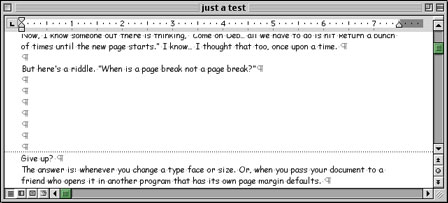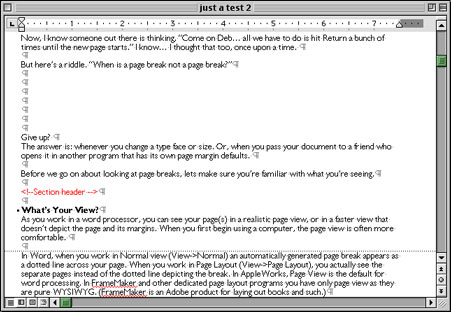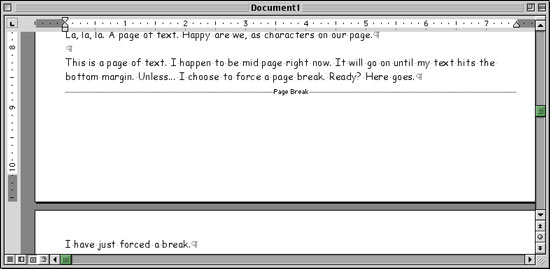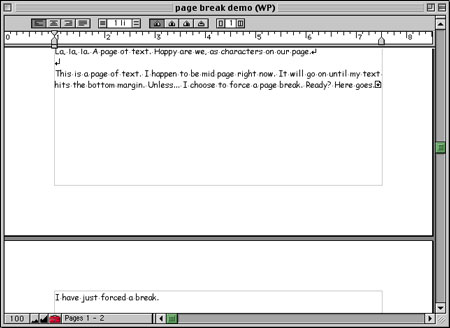|
||||
Page Breaks — Just Say WhenWritten and published August 2001 Note: This column cannot be found at MacCentral. When last I left you, we'd covered indents and outdents. This week I want to talk about something that is likely to sound silly to you. That's page breaks. Page breaks are something you don't normally think about. They're just something that happens automatically. But… there are times you want to determine a page break for yourself. For example, when you don't want a page to break mid-paragraph or mid-topic, Now, I know someone out there is thinking, "Come on Deb… all we have to do is hit Return a bunch of times until the new page starts." I know… I thought that too, once upon a time. But here's a riddle. "When is a page break not a page break?" Give up? The answer is: whenever you change a type face or size. Or, when you pass your document to a friend who opens it in another program that has its own page margin defaults. Before we go on about looking at page breaks, lets make sure you're familiar with what you're seeing. What's Your View?As you work in a word processor, you can see your page(s) in a realistic page view, or in a faster view that doesn't depict the page and its margins. When you first begin using a computer, the page view is often more comfortable. In Word, when you work in Normal view (View->Normal) an automatically generated page break appears as a dotted line across your page. When you work in Page Layout (View->Page Layout), you actually see the separate pages instead of the dotted line depicting the break. In AppleWorks, Page View is the default for word processing. In FrameMaker and other dedicated page layout programs you have only page view as they are pure WYSIWYG. (FrameMaker is an Adobe product for laying out books and such.) Automatic Page BreaksNow let's look at breaks more closely. As you create a document in a word processor, the program looks at the page size and page margins you've set in your Preferences and creates pages to fit your preferences. As you type, your text wraps from one line to another. Each time you press Return to begin a new paragraph, that new line takes room on your page. Eventually, you fill a page with your lines, whether content-containing, or blank lines. When you reach the end of a page, a new page generates automatically. Depending on your document view (see What's Your View), you either see a new "page" onscreen or see a dotted line depicting the page break. The automatically generated page break — pagination — is not a definite break. Instead, it wisely adjusts as you edit your page. That's part of the beauty of word processing. You just type and it takes care of the layout according to your settings. (If you ever used a typewriter, you may remember the experience of getting wrapped up in your typing only to look at the page eventually and see that you'd long ago typed your way off the page and your words were no longer landing on paper. Not fun. This never happens in a word processor. New pages are automatic. ) So now that you know the cool part of a page break, consider the pitfalls. • Where will the page break fall? Actually, it can fall anywhere. Word processors count lines and space used; they don't read your content and know when they're falling in the middle of an important thought within a paragraph. You, on the other hand, do read your content. And you don't always want a page break to cut across a paragraph. • What happens when you change the font in any way? Well, the page size doesn't actually change. Instead, the page break ends up at another point within your text. See, not only does the font size effect the layout, but the actual height of those blank lines changes too, so the page break can really be thrown off. • What happens when you open your page in another word processor? That depends on the two applications. In the cases I've experienced over the years, the page margins set for the opening application is seen, rather than the margins you'd set in the original page. This new margin causes the text to wrap differently than in your original. Thus, the page breaks come at points in your text other than the points you saw. • What happens when you open your page on another Mac using the same word processor — but you used a Post Script version of the font and the other Mac has the TrueType version of the same font? Each version is likely to be slightly different. Those different font metrics may cause the page breaks to shift. This is most likely to happen in long documents; the subtle difference becomes magnified at perhaps page 50 and finally shifts the page break. (Imagine what that does to a table of contents!) These shots (done in Word 98) show you the same exact document. First with Comic Sans as the font. Then after Edit->Select All and changing the font to Helvetica.
Forcing a BreakAutomatic pagination is nice and handy, but when we read a document the visual aspect of it plays a role in our interpretation. When we're considering a thought, it can be disconcerting to see that thought broken up. This is particularly noticeable with short paragraphs. Often, it's more desirable to have your page break fall a few lines sooner on a page, moving an entire paragraph to the next page. So what's the best way to move a paragraph to the next page? As demonstrated, hitting Return a few extra times can do the trick, but will wreak havoc on your pages when you change the font, add or delete some words, etc. Instead, use a hard page break. To add a hard page break — force a break — simply press Shift and Enter together. (That's the Enter key on the number pad, not the Return key on your letter pad.) This is pretty much a Mac standard so it should work in any word processor. Give it a try. Place your cursor just in front of the text that should start your new line, then press Shift-Enter. You can also add the break using menus. In AppleWorks, choose Format->Insert Page Break. In Word, choose Insert->Break, then click OK to accept the default. If you're using Word Perfect or Nisus, or another word processor, check similar menus for this command. Here is that same document, but with hard page break instead of multiple returns. Again, first with Comic Sans, as it was composed, and then with the type face changed to Helvetica.
By the way, you probably just noticed that is was pretty obvious there was a hard page break used in those last documents. (Word gives you a solid line instead of a dotted line, and also writes "page break" into the line to let you know you've got a hard break there.) Here's how you can tell there's a hard page break in Word's page layout view.
And here's how you can see a hard page break in AppleWorks. There, an icon pointing to the next page lets you know there's a break.
Hard page breaks are definite things.Edit as you may; the break remains. Depending on the layout of your document and how much editing you do, the break will either remain good-looking or will cause an extra small page between pages. You'll need to experiment with this ability. As a rule, don't add page breaks until you're pretty much done with your document. That is, when the text is nearly complete and the look of the text is set, Removing a Page BreakWondering how to remove a hard page break. Just put your cursor in front of the text that directly follows the break and hit the delete key. It deletes just like any other character. ConclusionHard page breaks are not a cure-all for your page formatting, but they can certainly be handy. Give 'em a try. I think you'll be proud of the results. And using them shows a professionalism bound to impress someone. Note: After this column, the next one was published in January 20001. |
||||


 <!
<! 
